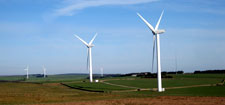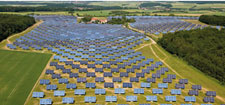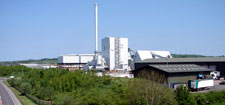Renewable Energy
In response to the threats posed by climate change the Government has set a target for reducing CO2 emissions by 60% by 2050. As one of the measures to meet that objective it is proposing to achieve 10% of electricity generation from renewable sources by 2010, and 20% by 2020.This requires a radical change in the way energy is generated and one that is likely to bring new forms of development and new crops to the rural landscape.
New renewable energy development can bring changes to the landscape in a number of ways.
- New development of an industrial nature in the countryside may be visually intrusive and may weaken its rural character.
- Large wind turbines may dominate the local landscape and be visible over extensive areas.
- New infrastructure in the form of access roads, power lines and substations may be damaging to landscape features or be visually intrusive.
- New energy crops may introduce novel features, textures or colours to farmland landscapes.
- New energy efficient buildings, or energy installations on existing buildings, may conflict with traditional architectural styles.
The North East renewable Energy Strategy (March 2005) published by the North East Assembly describes the renewable energy resources in the region and sets targets for energy generation to 2020.
Issues and Objectives
Planning for Renewable Energy
The Regional Spatial Strategy (RSS) provides the strategic planning policy framework for renewable energy development in the region. It sets sub-regional targets for energy generation, including a target of 82MW for County Durham. Local Plans contain more detailed policies, as will the Local Development Frameworks (LDFs) that replace them. The Landscape Assessment and Strategy will contribute to the preparation of LDFs, informing the formulation of policies and providing guidance on landscape issues.
Objectives
- To inform Local Development Framework policies.
Wind Energy
It is likely that wind energy will make the largest contribution to new renewable energy generation in the county in the coming decade. RSS identifies a number of ‘broad areas of least constraint’ for wind energy generation, which include the northern and southern uplands of the West Durham Coalfield, the East Durham Plateau and the Tees Plain. Modern wind turbines are uniquely large structures that occupy prominent locations and are generally highly visible. Their development always involves an impact on the character of the landscape. For some landscapes the consequences are greater than others. For example in the wild moorland landscapes of the North Pennines the introduction of large man made elements would entail more of a ‘step change’ in character than in settled landscapes which already contain man-made features like pylons, telecommunications and TV masts. In all landscapes there are local sensitivities. Small-scale topography, field and vegetation patterns may be dwarfed by tall structures. Turbines may interfere visually, or detract from the setting of, notable buildings, designed parks and gardens, or historic monuments. The tranquillity of the countryside may be disturbed by the presence of moving turbines. The movement or noise of turbines in close proximity may affect the amenity of local residents.
Physical, economic and environmental constraints are likely to make large parts of the county unsuited to development, and pressure is likely to be concentrated in certain areas. The pattern of constraints in County Durham is such that there are few opportunities for large or medium scale wind farms. Development is likely to take place largely in the form of smaller scale groups (up to five or six turbines). It is important that the cumulative impact of individual sites is taken into account and the right balance is struck between the concentration of development in some landscapes and the consequences to the wider landscape of a more dispersed pattern of development. It is important that local communities are involved at an early stage in the planning process and particularly in making judgements about the capacity of the local landscape to accommodate new development.
Objectives
- To ensure that wind energy development does not detract from the special qualities of designated landscapes and in particular the North Pennines AONB, the Durham Cathedral and Castle World Heritage Site, Scheduled Ancient Monuments and Historic Parks and Gardens.
- To ensure that the scale and form of wind farms is compatible with the character of the local landscape and the wider landscapes in which they are visible.
- To ensure that the cumulative impact of wind farms in any one locality is not excessive.
- To promote the involvement of local communities at an early stage in the planning process.
Biomass
Energy or heat can be produced in a number of ways from biomass – whether woody material from forest products, waste wood and energy crops like willow or poplar, or non-woody material such as biodegradable wastes and high energy crops. New facilities such as anaerobic digesters, power stations, and pyrolisis plants are likely to be proposed, some in rural locations close to their sources of materials. The introduction of unfamiliar crops may also have an impact on the landscape. Short rotation coppice in particular is likely to become more commonly planted. This can make a positive contribution to the character of some landscapes, as well as to their biodiversity, but will need careful site selection and design.
Objectives
- To ensure that new energy development respects the character of the local landscape and contributes to the strategy for the area.
- To encourage sensitive site selection and design in the planting of energy crops.
Other Technologies
Other renewables technologies – principally hydroelectric, solar and geo-energy – are likely to have relatively small-scale applications in the county in the immediate future. Impacts on the landscape are likely to be localised, but many suitable locations (for example the North Pennines Area of Outstanding Natural Beauty and Areas of High Landscape Value) are likely to be sensitive. Care will need to be taken to ensure that development respects the character of the local landscape, buildings and townscapes.
Objectives
- To ensure that new energy development respects the character of the local landscape and built environment.



